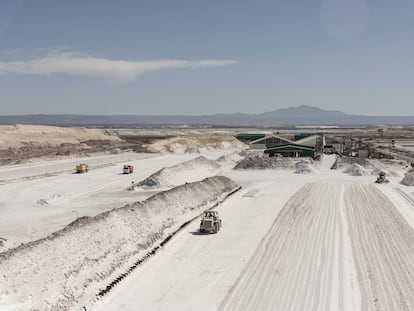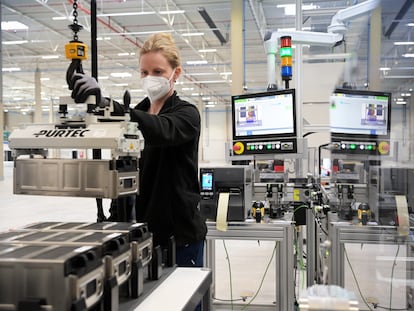Storm rages for key battery element after 2022 rush as price of lithium plunges nearly 50%
An increase in production has combined with a slump in demand for electric cars in China, but more factors are influencing lithium’s ups and downs

The transition to green energy and a complete revolution facing the auto industry is based on a peculiar metal: lithium. Smartphones, computers, vehicle batteries. What do they have in common? They rely on lithium, the lightest solid element in the world. Due to its light weight, energy storage capacity and resistance to depletion, it is unrivaled in battery production today. Amid growing demand, from the end of 2021 through 2022, the price of lithium and its two main derivatives (lithium hydroxide and lithium carbonate) soared to unprecedented heights.
The main winners in this particular lithium rush were, according to data from the International Energy Agency (IEA), the few players that dominate this market. There are large reserves that are widely distributed in different areas of the world. But according to the most recent data from the IEA, in 2019 Australia extracted approximately 50% of the world’s lithium, Chile more than 25% and China about 14%. In terms of processing the material into lithium hydroxide or lithium carbonate, China was the undisputed leader with more than 50% of the world’s refining capacity, followed by Chile with approximately 30%. In terms of market share by company, the US-based Albermale produced 24% of the world’s lithium, while Chile’s SQM Lithium contributed 12% and China’s Tianqi Lithium 11%.
Both processed lithium products are used for battery production. However, lithium hydroxide is more sought after because it has a higher lithium content and because it is more efficient in the production of cathode materials for lithium batteries. In other words, it allows batteries to last longer. After the 2022 rush, the price of both lithium hydroxide and lithium carbonate has plummeted in recent months, to such an extent that it even paralyzed China’s mining industry.
In addition, prices vary not only over time, but also by region. So, in Europe the cost of both derivatives tends to be higher than in China, the world’s leading battery producer. However, there has also been a considerable drop in the price per ton in Europe.
These price swings are the symptoms, but several other factors must be taken into account to understand the causes.
End of state aid in China
Since electric car batteries are made of lithium derivatives, it is not surprising that fluctuations in the electric car market help explain the large swings in the price of lithium, as well as the difference in price between Europe and China.
Behind the latest plunge in the price of lithium is a significant slowdown in Chinese electric car sales due to the end of electric vehicle subsidies. During 2022, electric car sales soared like never before in the Asian giant, but this suddenly changed with the new year. According to data from the China Association of Automobile Manufacturers (CAAM), passenger car production and sales were 1.397 million and 1.469 million respectively, down 34.3% and 35.2% month-on-month and 32.9% year-on-year.
“Due to the end of the subsidy policy for new energy vehicles and the obvious fluctuations in market prices, production and sales of new energy vehicles reached 425,000 and 408,000 in January, down 46.6% and 49.9% month-on-month and 6.9% year-on-year and 6.3%. The market share reached 24.7%,” writes CAAM.
In contrast, although it enjoys a lower penetration rate and share of total vehicle registrations, the electric vehicle market in Europe is more stable. This justifies the higher price of lithium, since Europe’s demand has not plummeted like it has in China. The latest registration data from ACEA, the European automobile industry association, shows that 151,573 units of battery-electric cars were registered across the EU in March, up 58% year-on-year. With this increase, 13.9% of the vehicles registered were of this type compared to 11.4% in March 2022.
A lithium plant is not a bakery
Asked about the causes for this volatility in the price of lithium, Luis Marquina, president of the Spanish association of batteries and energy storage (AEPIBAL), uses a metaphor to answer. Marquina points out that beyond the Chinese factor (which he also alludes to), there is a big difference between a bakery and a lithium production facility.
“It’s about the industrial work that’s involved when demand grows It’s not as simple as in the case of a bakery, where, if the business is doing very well, they can buy the premises next door and expand. Lithium [production] is an industrial process that takes time to implement and develop,” he says.
“Over a period of time, the lithium hydroxide and lithium carbonate manufacturers (which are mostly Chinese) realized that there was much more demand than supply for lithium, and so they started to expand their production capacity. That took a while. Now, a peak in production has coincided with the end of electric vehicle subsidies in China. What has happened recently is that a large quantity of lithium carbonate and lithium hydroxide has already been accumulated and, therefore, the price has gone down. Increased production capacity together with the drop in consumption leads to this drop in prices,” says the expert.
Unlike in other commodity markets, lithium producers have tended not to commit to overly high production targets so as not to fall prey to the impossibility of scaling up production sufficiently.
“As the electric vehicle penetration ratio has gone from 1.6% five years ago to more than 10% in 2022, producers have been able to deliver more lithium in 2022 than they had anticipated in each of the previous three years. This is in stark contrast to the more mature copper market, in which mining companies often tend to under-deliver,” writes Bank of America.
The lithium market is different from the copper market, but its operating logic is somewhat similar to that of crude oil. However, there are many differences between the mature oil market and one that is in a state of flux. In addition to being the result of political decisions via premeditated production cuts, the oil market also responds to the logic of production and the incentives that determine its price. This is something that is extremely volatile in lithium. When the price of crude oil rises, producers find a good reason to “expand the bakery” and invest more money and make extra efforts in order to produce more barrels of oil. Once the extra effort bears fruit and that oil hits the market, the price drops again. Another nuance. This is not always the case, as the shift towards a less polluting economy has put downward pressure on investments in fossil fuels and has pushed up investments in those related to green energy. In the words of Aramco CEO Amin Nasser, “investment in the upstream sector is between $370 billion and $400 billion, when in 2014 it was around $700 billion,” he explained to CNBC in a recent interview.
What can we expect for the price of lithium?
In relation to what is to be expected, Marquina stresses first of all that there is no shortage of lithium. “That’s not a problem. New lithium deposits are constantly being found. Where there is a problem is in the process of lithium extraction, in the start-up of a mining plant. It takes at least 10 years to start producing. It may happen that in any of the electric car markets the prices of these vehicles will go down, which will cause the price of lithium to shoot up again in the medium term, in six or seven years, but not because there is a lack of lithium per se, but because of a lack of mining capacity,” he predicts.
For their part, Bank of America reinforces Marquina’s view. “Lithium has been extremely volatile and we expect further price declines. We believe that lithium is a capital-intensive commodity, but not constrained by scarcity. What do we mean by this? There is no shortage of lithium deposits, so producers can increase their production, which is another reason to expect price falls throughout 2023 and 2024″, analysts believe.
However, there are also factors that can catapult the price of lithium skywards. In addition to an electric vehicle boom, the way supply chains are behaving may also make the metal more expensive. “A multipolar production scenario is forming, in which lithium hydroxide and lithium carbonate manufacturers are going to be very close to lithium deposits. This is exactly what is being projected in Extremadura [Spain]. In the medium term, we are moving towards a scenario with many plants around the world wherever there are lithium deposits. We will see it in Iran, Chile, India, the United States, Bolivia and we could also see it in Europe,” says Marquina.
“The industrial policies of the United States and the European Union, with their vision of bringing lithium production closer to their borders, should raise the minimum price of lithium. Along with possible exponential demand at the same time as this relocation of supply chains occurs, we may see periodic shortage scenarios. In other words, volatility is here to stay,” says Bank of America. As part of the Critical Raw Materials Act, the European Union has considered legislating for 30% of the demand for refined metals to be supplied from within the Union itself by 2030.
Besides these factors that currently influence the price or may do so in the future, innovation is also important. Inexpensive, lithium-free, but fragile, sodium batteries have been one of the alternative avenues of research. According to Bank of America, the Chinese company Sehol presented a compact vehicle powered by this type of battery. The core of this vehicle had an energy density of 120 Watts per kilogram. To put that into context, Tesla’s Model 3 battery has about 300 Watts per kilogram. Meanwhile, Argonne National Laboratories has published research on a lithium-air battery that could reach an energy density of 1,200 Watts per kilogram.
Sign up for our weekly newsletter to get more English-language news coverage from EL PAÍS USA Edition
Tu suscripción se está usando en otro dispositivo
¿Quieres añadir otro usuario a tu suscripción?
Si continúas leyendo en este dispositivo, no se podrá leer en el otro.
FlechaTu suscripción se está usando en otro dispositivo y solo puedes acceder a EL PAÍS desde un dispositivo a la vez.
Si quieres compartir tu cuenta, cambia tu suscripción a la modalidad Premium, así podrás añadir otro usuario. Cada uno accederá con su propia cuenta de email, lo que os permitirá personalizar vuestra experiencia en EL PAÍS.
¿Tienes una suscripción de empresa? Accede aquí para contratar más cuentas.
En el caso de no saber quién está usando tu cuenta, te recomendamos cambiar tu contraseña aquí.
Si decides continuar compartiendo tu cuenta, este mensaje se mostrará en tu dispositivo y en el de la otra persona que está usando tu cuenta de forma indefinida, afectando a tu experiencia de lectura. Puedes consultar aquí los términos y condiciones de la suscripción digital.
More information
Archived In
Últimas noticias
Alain Aspect, Nobel laureate in physics: ‘Einstein was so smart that he would have had to recognize quantum entanglement’
Imelda Castro, the woman who wants to rule the cartel battleground of Sinaloa
The new victims of the Republican war on Obamacare: Millions hit by soaring health insurance premiums
A country divided on migrant rights: Some US states expand protections while others restrict them
Most viewed
- David King, chemist: ‘There are scientists studying how to cool the planet; nobody should stop these experiments from happening’
- Reinhard Genzel, Nobel laureate in physics: ‘One-minute videos will never give you the truth’
- Oona Chaplin: ‘I told James Cameron that I was living in a treehouse and starting a permaculture project with a friend’
- Sinaloa Cartel war is taking its toll on Los Chapitos
- Mexico completes its trade shift with the entry into force of tariffs on China and countries without trade agreements











































